The Sculptor Galaxy is an intermediate spiral galaxy located approximately 11.4 million light-years away in the southern constellation Sculptor. It is one of the brightest galaxies in the night sky, easily observed in binoculars and small telescopes. The galaxy has the designation NGC 253 in the New General Catalogue. It is sometimes known as the Silver Coin or Silver Dollar Galaxy.
With an apparent magnitude of 8.0 and an apparent size of 27.5 by 6.8 arcminutes, the Sculptor Galaxy is an easy target for amateur astronomers. It appears slightly longer, thinner, and fainter than Bode’s Galaxy (Messier 81) in Ursa Major, but significantly brighter and larger than the Cigar Galaxy (Messier 82). If not for its location in the southern sky, NGC 253 would have likely been spotted by Charles Messier and included in his catalogue. It is one of the easiest spiral galaxies to observe, along with the Andromeda Galaxy (Messier 31) and Bode’s Galaxy (Messier 81).
The Sculptor Galaxy is one of the bright deep sky objects included by Sir Patrick Moore in the Caldwell catalogue of objects visible in amateur telescopes. It is catalogued as Caldwell 65.
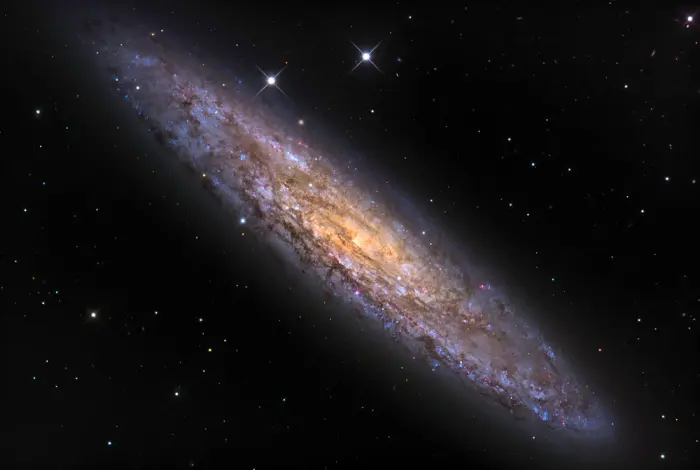
Sculptor Galaxy (NGC 253), image credit: Adam Block/Mount Lemmon SkyCenter/University of Arizona (CC BY-SA 4.0)
NGC 253 is one of the intrinsically brightest galaxies in the Milky Way’s neighbourhood. The only galaxies that are brighter are the Andromeda Galaxy (M31) and the Sombrero Galaxy (M104).
The Sculptor Galaxy contains a supermassive black hole with a mass about 5 million times that of the Sun, slightly heavier than the Milky Way’s central black hole, Sagittarius A*. The black hole was detected by NASA’s Chandra X-ray Observatory in 2003 and its presence confirmed by NASA’s Nuclear Spectroscopic Telescope Array (NuSTAR) in 2012. It is believed to currently be dormant, which is unusual considering all the starburst activity around it.
NGC 253 is classified as a starburst galaxy. It is going through a period of intense star formation and experiencing an exceptionally high rate of star forming activity compared to most other galaxies. The current high rate of star formation has earned the galaxy the designation of a starburst galaxy. Australian astronomer Bernard Y. Mills discovered NGC 253 to be a moderately strong radio source.
The Sculptor Galaxy was imaged by NASA’s Hubble Space Telescope (HST) in 1998. The Hubble image revealed young star clusters and complex structures of dark dust lanes and clumpy gas clouds.
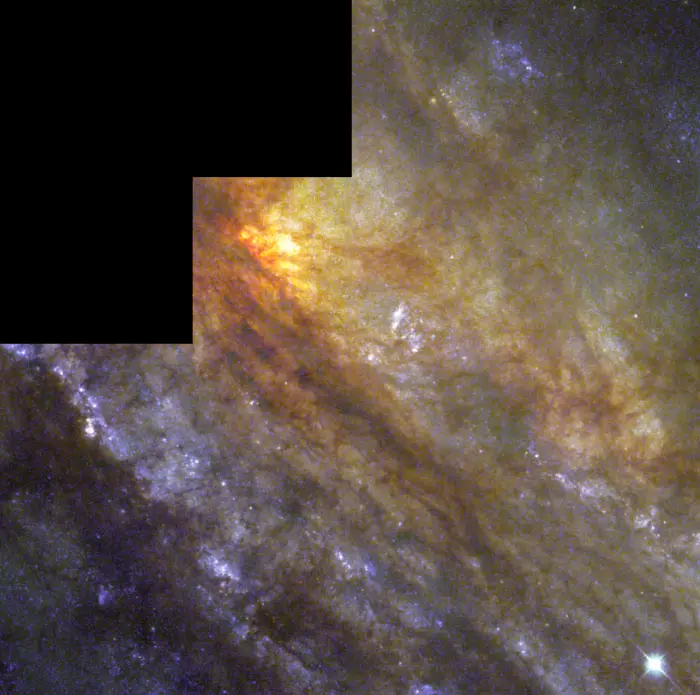
This Hubble image, taken with the Wide Field and Planetary Camera 2 in 1998, focuses in on stars and dust near the center of the Sculptor Galaxy (Caldwell 65). Credit: NASA, ESA and the Hubble Heritage Team (STScI/AURA); Acknowledgment: A. Watson (Instituto de Astronomía, Universidad Nacional Autónoma de México (CC BY 2.0)
Sculptor Group
The Sculptor Galaxy is the largest member of the Sculptor Group, one of the nearest groups of galaxies to the Local Group. The group lies about 12.7 million light-years from the centre of the Milky Way. It is sometimes referred to as the South Galactic Pole Group because it appears close to the south galactic pole (SGP). The SGP lies in the region between NGC 253 and the blue giant Alpha Sculptoris.
NGC 253 and a few of its neighbours – NGC 247 (the Claw Galaxy), PGC 2933, PGC 2881, UGCA 15, and Sculptor-dE1 – form the gravitationally-bound core of the group. The members of the group are weakly gravitationally bound to the core and the group is believed to be in an early evolutionary stage. It has been referred to as a filament. Galaxies are still falling into it along filamentary structures.
The brightest members of the Sculptor Group include the Sculptor Galaxy (NGC 253), the intermediate spiral galaxy NGC 247 (mag. 9.9) in the constellation Cetus, the flocculent spiral NGC 7793 (mag. 10.0) in Sculptor, and the dwarf barred spiral galaxy NGC 625 (mag. 11.7) and the irregular PGC 6430 in Phoenix. The bright foreground galaxies NGC 55 (Caldwell 72) and NGC 300 (Caldwell 300) are not members of the group. They are believed to form a gravitationally bound pair.
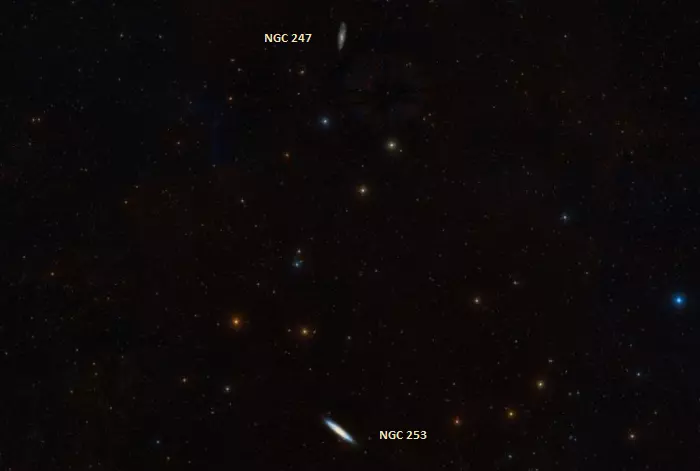
The Sculptor Galaxy (NGC 253) and the Claw Galaxy (NGC 247), image: Wikisky
Facts
The Sculptor Galaxy was discovered by the German astronomer Caroline Herschel in 1783. Herschel spotted the galaxy while searching for comets. Her nephew, the English astronomer John Herschel observed the galaxy using his 18-inch metallic mirror reflector from the Cape of Good Hope in South Africa about 50 years later and described it as “very bright and large, 24’ in length; a superb object.”
American astronomer Allan Sandage described NGC 253 as “the prototype example of a special subgroup of Sc systems” in The Hubble Atlas of Galaxies (1961), adding, “photographic images of galaxies of the group are dominated by the dust pattern. Dust lanes and patches of great complexity are scattered throughout the surface. Spiral arms are often difficult to trace… The arms are defined as much by the dust as by the spiral pattern.”

Dark dust clouds and scattered massive stars obscure much of the Sculptor Galaxy’s detail, which is why Hubble imaged it in both visible and infrared light with its Advanced Camera for Surveys (ACS). Infrared observations allow us to peer through the shrouds of dust, revealing details that are otherwise hidden from view. Thanks to Hubble’s observations, scientists have discovered that all of the dust in the Sculptor Galaxy is accompanied by frantic star formation, earning it the designation of a starburst galaxy. This Hubble image shows about half of the galaxy. Image credit: NASA, ESA, J. Dalcanton and B. Williams (University of Washington), T.A. Rector/University of Alaska Anchorage, T. Abbott and NOAO/AURA/NSF
Location
The Sculptor Galaxy lies in the constellation Sculptor, near the border with Cetus. It appears 7.5 degrees south of Diphda (Beta Ceti), the brightest star in Cetus, in the region between Diphda and Alpha Sculptoris, the brightest star in Sculptor.
The Sculptor Galaxy is located in the same area of the sky as the fainter spiral galaxy NGC 247 (Caldwell 62) and the globular cluster NGC 288. The bright Fomalhaut in Piscis Austrinus can be used for orientation.
Diphda can be identified using the bright stars of the Great Square of Pegasus. It is the brightest star just east of the imaginary line extended from Alpheratz through Algenib. Shining at magnitude 2.02, the orange giant is easily visible even in less-than-ideal conditions.
The same cannot be said for Alpha Sculptoris. The hot blue giant shines at magnitude 4.30 from a distance of 780 light-years and is difficult to see from urban areas.
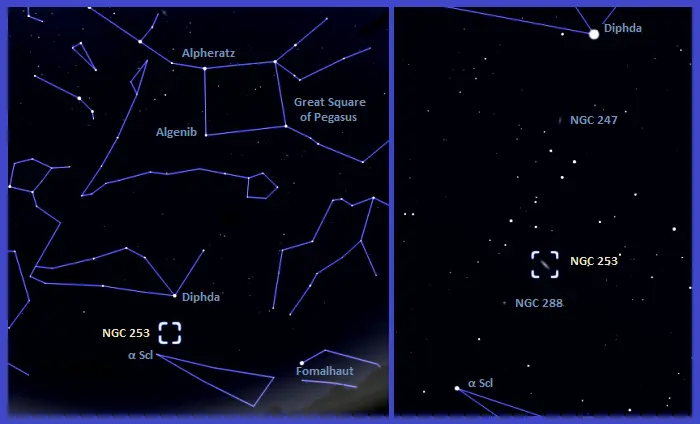
The location of the Sculptor Galaxy (C65), image: Stellarium
NGC 253 is best observed in 12-inch (300 mm) or larger telescopes, which reveal its elongated oval bulge and streaky disk. 16-inch telescopes will show a dark dust lane northwest of the galaxy’s core, as well as about a dozen of faint foreground stars.
The Sculptor Galaxy lies only 1.8 degrees northwest of the globular cluster NGC 288. The star cluster has an apparent magnitude of 9.37 and an apparent size of 13.8 arcminutes. It can be spotted in binoculars.
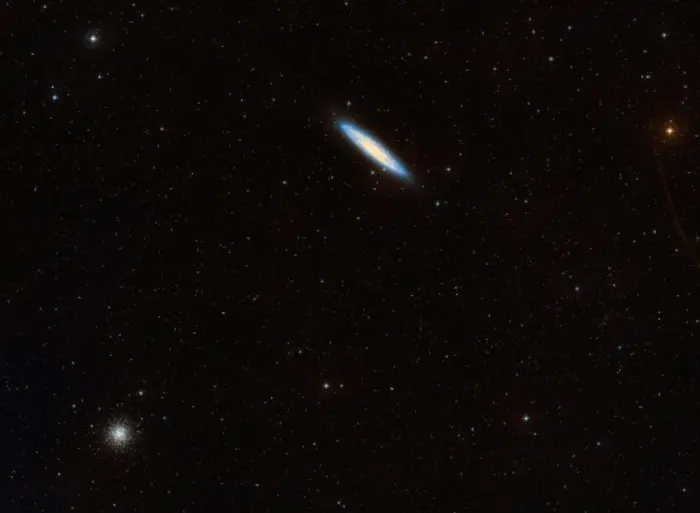
The Sculptor Galaxy and the globular cluster NGC 288, image: Wikisky
The best time of the year to observe the Sculptor Galaxy and other deep sky objects in Sculptor is during the month of November, when the constellation rises higher above the horizon around 9 pm.
Sculptor Galaxy – NGC 253
| Constellation | Sculptor |
| Right ascension | 00h 47m 33.134s |
| Declination | −25° 17′ 19.68″ |
| Type | SAB(s)c |
| Distance | 11.4 ± 0.7 million light-years (3.5 ± 0.2 megaparsecs) |
| Apparent magnitude | 8.0 |
| Angular size | 27′.5 × 6′.8 |
| Diameter | 90,000 light-years |
| Redshift | 0.000811 |
| Helio radial velocity | 243 ± 2 km/s |
| Names and designations | Sculptor Galaxy, NGC 253, Caldwell 65, Silver Coin Galaxy, Silver Dollar Galaxy, Sculptor Filament, UGCA 13, PGC 2789, LEDA 2789, AGC 20535, ESO 474-29, MCG-04-03-009, MRC 0045-255, NVSS J004733-251717, IRAS 00450-2533, 2MASX J00473313-2517196, RAFGL 5038 |
IMAGES
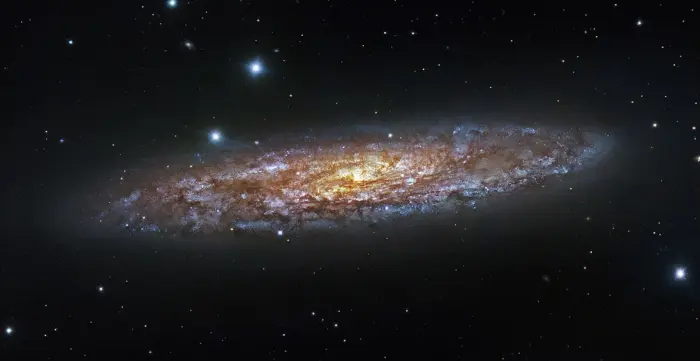
NGC 253, also known as the Sculptor Galaxy, is the brightest of the Sculptor Group of galaxies, found in the constellation of the same name, and lying approximately 13 million light-years from Earth. The Sculptor Galaxy is known as a starburst galaxy for its current high rate of star formation, one result of which is its superwind, a stream energetic material spewing out from the center of the galaxy out into space. The purple light comes from that frenzy of star formation, which originally began 30 million years ago, while the yellowish color is created by dust lit up by young, massive stars. This image combines observations performed through three different filters (B, V, R) with the 1.5-metre Danish telescope at the ESO La Silla Observatory in Chile. Credit: ESO/IDA/Danish 1.5 m/ R. Gendler, U. G. Jørgensen, J. Skottfelt, K. Harpsøe (CC BY 4.0)
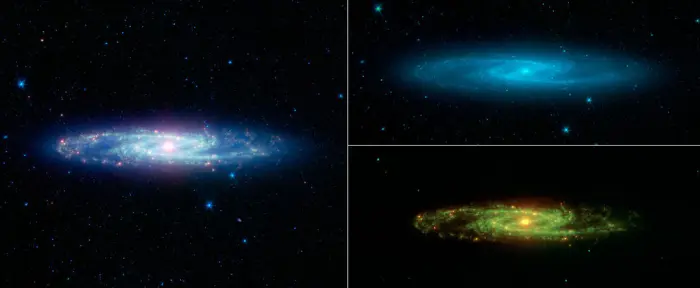
The spectacular swirling arms and central bar of the Sculptor Galaxy are revealed in this view from NASA’s Spitzer Space Telescope. The main image is an infrared composite combining data from two of Spitzer’s detectors taken during its early cold, or cryogenic, mission. Also known as NGC 253, the Sculptor Galaxy is part of a cluster of galaxies visible to observers in the southern hemisphere. It is known as a starburst galaxy for the extraordinarily strong star formation in its nucleus. This activity warms the surrounding dust clouds, causing the brilliant yellow-red glow in the center of this infrared image. Image credit: NASA/JPL-Caltech
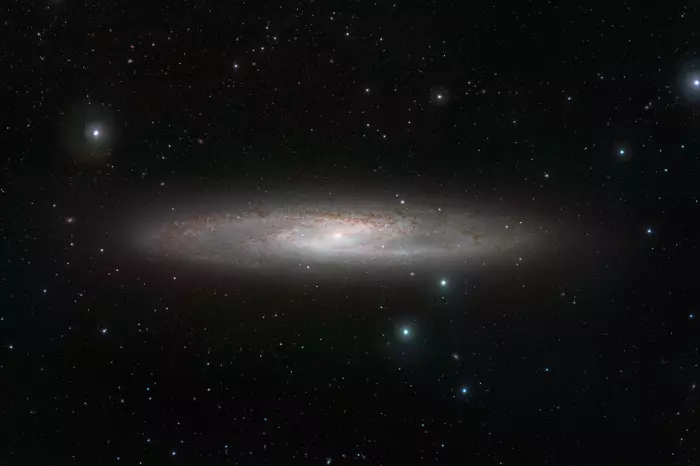
NGC 253 is one of the closest galaxies to our own. It is a bright spiral that lies about 13 million light-years from Earth in the southern constellation of Sculptor and is noted for being a starburst galaxy with very vigorous star formation and very dusty spiral arms. In the infrared, the rich dust clouds in the galaxy’s spiral arms become nearly transparent and a whole host of cool red stars that are otherwise invisible can be seen. The VISTA infrared images were taken through Y, Z, J, Ks and narrowband filters. The field of view is about 38 by 25 arcminutes. Image credit: ESO/J. Emerson/VISTA. Acknowledgment: Cambridge Astronomical Survey Unit (CC BY 3.0)
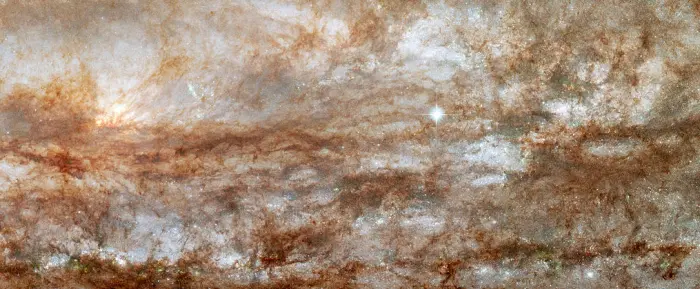
A portion of the spiral galaxy the Sculptor Galaxy (NGC 253) as viewed by the Hubble Space Telescope. NGC 253 is ablaze with the light from thousands of young, blue stars. The spiral galaxy is undergoing intense star formation. The image demonstrates the sharp “eye” of the Advanced Camera, which resolved individual stars. The dark filaments are clouds of dust and gas. NGC 253 is the dominant galaxy in the Sculptor Group of galaxies and it resides about 13 million light-years from Earth. Image credit: NASA, ESA, J. Dalcanton and B. Williams (University of Washington)
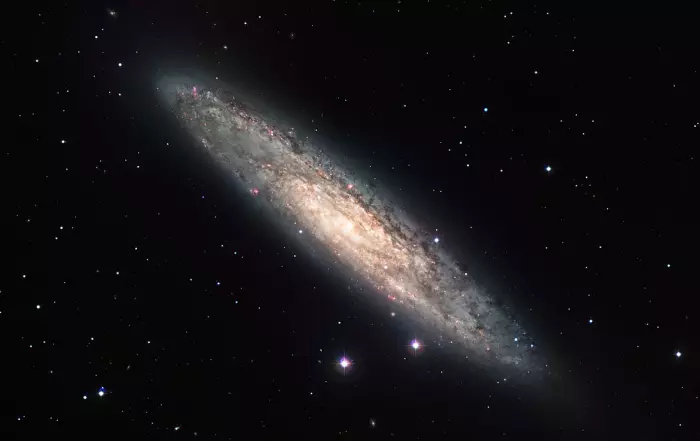
Measuring 70 000 light-years across and laying 13 million light-years away, the nearly edge-on spiral galaxy NGC 253 is revealed here in an image from the Wide Field Imager (WFI) of the MPG/ESO 2.2 m telescope at the La Silla Observatory. The image is based on data obtained through four different filters (R, V, H-alpha and OIII). North is up and East to the left. The field of view is 30 arcminutes. Credit: (CC BY 4.0)
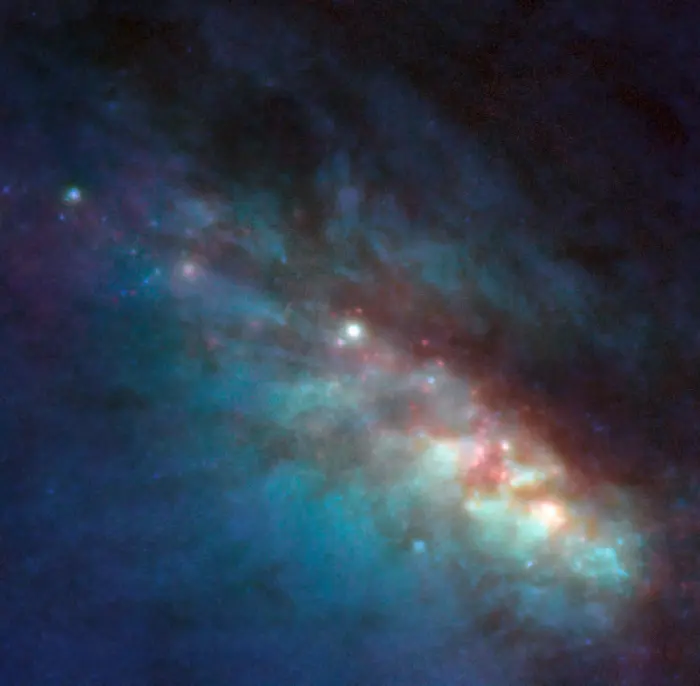
Close-up of the central regions of the starburst galaxy NGC 253. This image is based on data obtained with the NACO instrument on ESO’s Very Large Telescope (VLT) and the ACS on the NASA/ESA Hubble Space Telescope. Thanks to the VLT’s sharp eye, astronomers have identified 37 bright regions, a threefold increase on previous results. These regions are probably very active nurseries that contain as many as one hundred thousand young, massive stars bursting from their dusty cocoons. The field of view is 15 arcseconds. Image credit: ESO (CC BY 4.0)